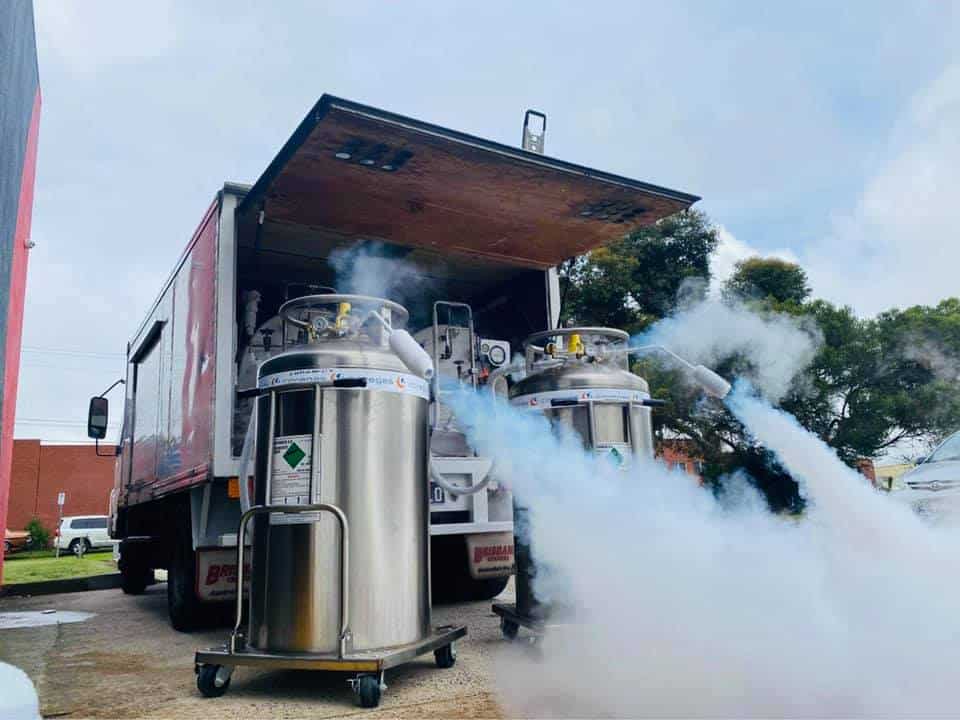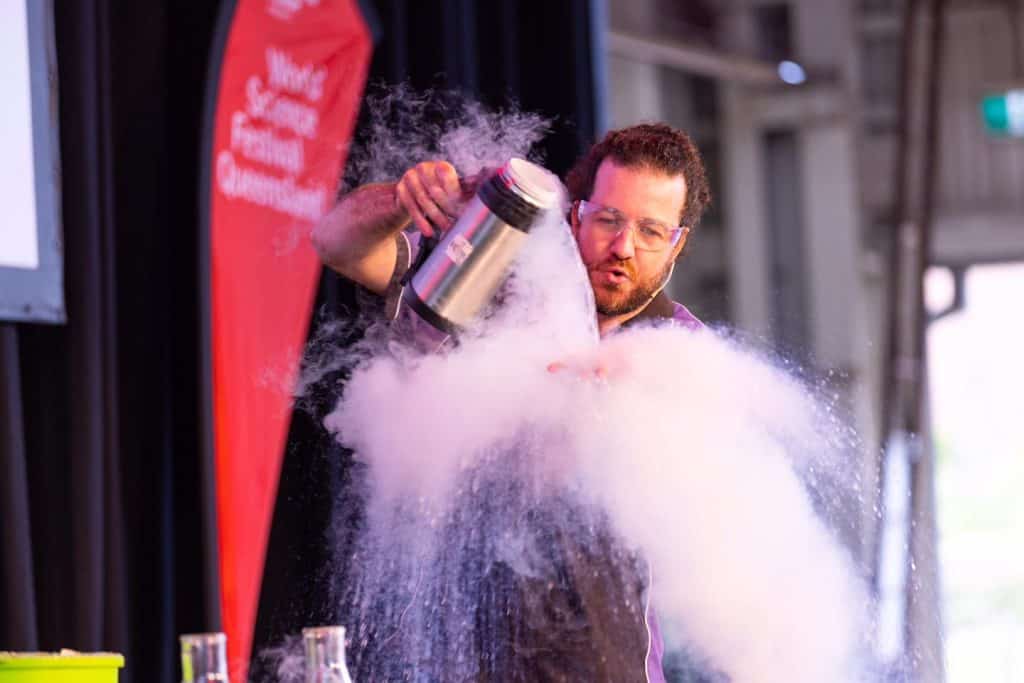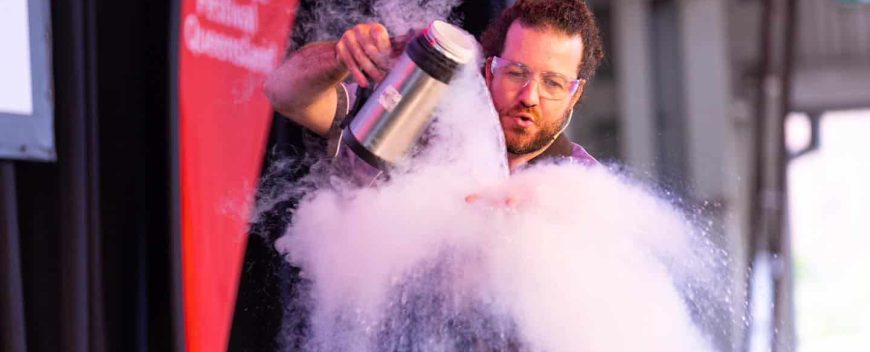Written by Aimee Wilson
My last Liquid Nitrogen FAQs article prompted a bit of a brainstorm here at Big Bang HQ, which revealed to me that I had barely scratched the surface in terms of addressing the questions that are most frequently asked about liquid nitrogen in our shows and workshops. So here I have for you Part Two.
Can I have some liquid nitrogen?
Short answer: No.
Slightly longer answer: Liquid nitrogen is relatively easy to buy, from specialist gas suppliers such as BOC and Air Liquide (and our favourites, The Cryogenics Group). But none of these very responsible companies will let you have any liquid nitrogen without the proper storage container. This container is called a Dewar (rhymes with skewer), and was named after its inventor, James Dewar. A Dewar is basically two flasks, one inside the other, sealed at the top and with the air removed to create a vacuum between the layers. A vacuum is a good insulator, which is important for maintaining the low temperature of liquid nitrogen – as we know, as soon as it comes into contact with something warmer than -192°C, it evaporates into gas. So the inner flask is filled with the liquid nitrogen, and the vacuum keeps it from evaporating too quickly.

Another key feature of the liquid nitrogen dewar is its lid. The vacuum container does a pretty good job of keeping the liquid nitrogen cold, but with such an extreme temperature difference between it and the surrounding environment, it’s near impossible to completely prevent any evaporation. So the lid of the dewar is not sealed, and just sits loosely in the neck of the flask, which allows the gas to escape. If the lid was sealed (or the flask opening was otherwise blocked in some way), the evaporating gas would gradually build up pressure, eventually causing the whole thing to explode. And as much as we love a Big Bang, this would not be ideal.
So to answer your question… Yes, actually, you can have some liquid nitrogen. But first you’ll have to acquire yourself a dewar. They come in many sizes, and like most things, in many price ranges depending on where you shop, but even the cheapest smallest one is likely to set you back at least a few hundred dollars. Large ones for science lab (or science show) use that hold 20-30 litres can cost upwards of $2000. And then on top of that, you have to buy your liquid nitrogen, which is around $6 per litre. So I guess what I’m trying to say is… booking a science show with us is probably a far more economical option.
Why is it making smoke?
Short answer: It’s not – it’s a cloud.
Slightly longer answer: One of the most visually exciting features of liquid nitrogen is the billowing cloud that surrounds it as soon as it’s poured. There are many hypotheses from audience members as to what causes this – is it smoke, is it steam, or is it the nitrogen gas we can see evaporating? It is actually none of the above, but in fact, a cloud – just like the ones you see in the sky.
Smoke comes from things being burned. Burning, or combustion, is a type of chemical reaction which also results in a phase change of the fuel being burned (usually from solid or liquid to gas), but the smoke itself is made up of tiny solid particles in the air (the bit you can see), plus a bunch of invisible gases including carbon dioxide, carbon monoxide, and various others which depend on what is burning.
Fire needs three things in order to burn:
a. oxygen,
b. heat, and
c. fuel.
Given that liquid nitrogen is:
a. nitrogen,
b. cold, and
c. inert (doesn’t readily participate in chemical reactions), it would be virtually impossible to burn it.
So the clouds are not smoke.

Steam consists of water vapour, which is tiny bits of water suspended in the air, and happens when water boils (above 100 degrees Celsius) and evaporates. Water vapour itself, like almost all gases, is invisible – the steam we see is those droplets of water condensing back into liquid as they cool.
Nitrogen gas is also invisible – which is fortunate, as we are surrounded by it in the atmosphere, and it being visible would make it very difficult to see what was going on around us. The cloud billowing off the liquid nitrogen is indeed caused by the gas evaporating, but the bit we can see is again formed by tiny droplets of water in the air condensing into liquid. As the liquid nitrogen evaporates, it is still very cold (remember, it only needs to be just warmer than -192°C). There is always some water vapour in the air, which varies depending on how warm and humid the weather is that day. When the cool gas hits the water vapour, it condenses the water into tiny droplets of liquid water, which stay suspended in the air, forming a cloud.
Liquid nitrogen clouds are therefore similar to steam clouds, in the sense that both consist of droplets of liquid water. However, you may notice that the steam on a boiling saucepan of water rises, while the liquid nitrogen cloud sinks and seems to creep across the floor. This is simply due to the fact that heat rises – warmer gases will rise above cooler ones, and vice versa. (You can observe the same phenomenon if you have a fridge-freezer – open the freezer door and watch the cold air turn the water vapour into a cloud, which sinks down to the floor and makes your feet cold. But don’t just stand there with the freezer open, even if it is for science – whoever pays for the electricity is likely to get cross.)
So there you have Part Two of Liquid Nitrogen FAQs. You are pretty much a liquid nitrogen expert now, and will be able to join us in our quest to educate everyone on the wonders and myths surrounding our favourite chilly chemical. And if you’d like to see it in action, have a look at our Big Bang Science Show, Year 3 Heat & States of Matter workshop program, or Edible Science holiday program!



